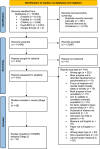Measures of Sleep-Related Fears in Children: A Systematic Review of Psychometric Properties Using COSMIN
- PMID: 40397330
- PMCID: PMC12162706
- DOI: 10.1007/s10567-025-00526-6
Measures of Sleep-Related Fears in Children: A Systematic Review of Psychometric Properties Using COSMIN
Abstract
Sleep-related fears (i.e. fears related to sleep, nighttime and/or occurring before sleep) are linked to the development of anxiety and sleep problems in children. Parent- and child-report measurement tools are key to increasing understanding and facilitating better identification for treatment to prevent disorder development. We conducted a systematic review with the aim of identifying the breadth of parent- and child-report measures that include an assessment of sleep-related fears in children from 7 to 12 years old (stage 1) and reviewing the psychometric properties of measures that more comprehensively assess sleep-related fears (i.e. 3 or more items) using the COSMIN checklist (stage 2) to provide recommendations for measures (stage 3). A systematic search was performed using MEDLINE, EMBASE, ERIC and PsycINFO in accordance with PRISMA guidelines. At stage 1, we retrieved 14,495 records. Of these, 66 papers met eligibility and included 43 distinct measures. At stage 2, 11 out of the 43 measures met criteria for more comprehensive measurement of sleep-related fears. Findings demonstrated mixed and incomplete data and very little high-quality evidence. No measures met criteria for recommendation and the majority of measures require further validation studies.
Keywords: Anxiety; COSMIN; Children; Measures; Review; Sleep.
© 2025. The Author(s).
Conflict of interest statement
Declarations. Competing Interests: The authors declare no competing interests. Ethical approval: This is a systematic review reporting on existing research studies and therefore, ethical approval was not required.
Similar articles
-
Folic acid supplementation and malaria susceptibility and severity among people taking antifolate antimalarial drugs in endemic areas.Cochrane Database Syst Rev. 2022 Feb 1;2(2022):CD014217. doi: 10.1002/14651858.CD014217. Cochrane Database Syst Rev. 2022. PMID: 36321557 Free PMC article.
-
Evaluating patient-reported outcome measures (PROMs) for bladder cancer: a systematic review using the COnsensus-based Standards for the selection of health Measurement INstruments (COSMIN) checklist.BJU Int. 2018 Nov;122(5):760-773. doi: 10.1111/bju.14368. Epub 2018 Jun 8. BJU Int. 2018. PMID: 29726085 Free PMC article.
-
Cognitive-behavioral versus non-directive therapy for preschoolers with severe nighttime fears and sleep-related problems.Sleep Med. 2017 Apr;32:40-47. doi: 10.1016/j.sleep.2016.12.011. Epub 2016 Dec 23. Sleep Med. 2017. PMID: 28366341 Clinical Trial.
-
Protocol for a systematic review evaluating psychometric properties and gender-related measurement (non)invariance of self-report assessment tools for autism in adults.Syst Rev. 2024 Jul 19;13(1):188. doi: 10.1186/s13643-024-02604-2. Syst Rev. 2024. PMID: 39030636 Free PMC article.
-
Psychometric Properties of Parent-Child (0-5 years) Interaction Outcome Measures as Used in Randomized Controlled Trials of Parent Programs: A Systematic Review.Clin Child Fam Psychol Rev. 2019 Jun;22(2):253-271. doi: 10.1007/s10567-019-00275-3. Clin Child Fam Psychol Rev. 2019. PMID: 30734193 Free PMC article.
References
-
- Aji, M., Glozier, N., Bartlett, D. J., Grunstein, R. R., Calvo, R. A., Marshall, N. S., White, D. P., & Gordon, C. (2022). The effectiveness of digital insomnia treatment with adjunctive wearable technology: A pilot randomized controlled Trial. Behavioral Sleep Medicine,20(5), 570–583. 10.1080/15402002.2021.196715 - PubMed
-
- Akerstedt, T., Kecklund, G., & Axelsson, J. (2007). Impaired sleep after bedtime stress and worries. Biological Psychology,76(3), 170–173. 10.1016/j.biopsycho.2007.07.010 - PubMed
-
- Alfano, C. A., Ginsburg, G. S., & Kingery, J. N. (2007). Sleep-related problems among children and adolescents with anxiety disorders. Journal of the American Academy of Child and Adolescent Psychiatry,46(2), 224–232. 10.1097/01.chi.0000242233.06011.8e - PubMed
Publication types
MeSH terms
Grants and funding
LinkOut - more resources
Full Text Sources
Medical
Miscellaneous


